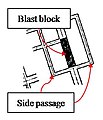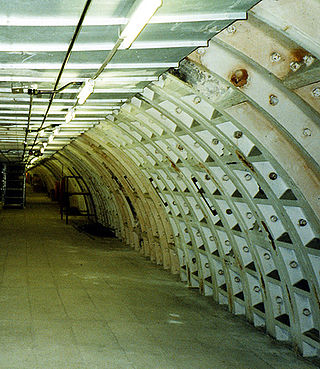
The London deep-level shelters are eight deep-level air-raid shelters that were built under London Underground stations during World War II.

Mount Albert is an inner suburb of Auckland, New Zealand, which is centred on Ōwairaka / Mount Albert, a local volcanic peak which dominates the landscape. By 1911, growth in the area had increased to the point where Mount Albert was declared an independent borough, which was later absorbed into Auckland. The suburb is located 7 kilometres (4.3 mi) to the southwest of the Auckland City Centre.
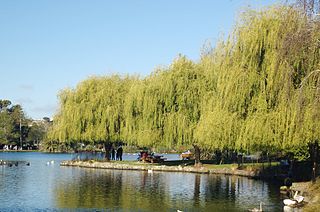
Western Springs is a residential suburb in the city of Auckland in the north of New Zealand. It is located four kilometres to the west of the city centre, Auckland CBD. The park is situated to the north of State Highway 16 and the residential suburb is located southeast of the park on the opposite side of State Highway 16.

Waitematā railway station, formerly known as Britomart Transport Centre, is the public transport hub in the central business district of Auckland and the northern terminus of the North Island Main Trunk railway line. It combines a railway station in a former Edwardian post office, extended with expansive modernist architectural elements, with a bus interchange. It is at the foot of Queen Street, the main commercial thoroughfare of the CBD, with the main ferry terminal just across Quay Street.

Albert Park is a public park in central Auckland, bounded by Wellesley Street East, Princes Street, Bowen Avenue and Kitchener Street. From the entrance at the corner of Bowen Ave and Kitchener St, sealed footpaths climb steeply through native trees to the large flat area at the summit, where a formal layout of paths and flower gardens encircle a fountain.

Morningside is a suburb of Auckland, New Zealand. It lies four kilometres south-west of the city centre, close to Eden Park and Western Springs Reserve.

Berlin Hermannstraße is a railway station in the Neukölln district of Berlin. It is served by the S-Bahn lines S41, S42, S45, S46 and S47 and the U-Bahn line U8, of which it is the southern terminus. It was formerly also possible to transfer there to the Neukölln-Mittenwalde railway line, which is now only used for goods traffic.

The Wynyard Quarter is a reclaimed piece of land on the Waitematā Harbour at the western edge of the Auckland waterfront, New Zealand.
The Carrière Wellington is a museum in Arras, northern France. It is named after a former underground quarry which was part of a network of tunnels used by forces of the British Empire and Commonwealth during the First World War. Opened in March 2008, the museum commemorates the soldiers who built the tunnels and fought in the Battle of Arras in 1917.
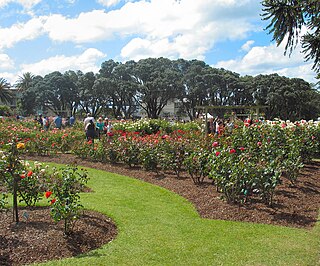
Dove-Myer Robinson Park, more commonly known as the Parnell Rose Garden, is a park in Parnell, Auckland, New Zealand. The park is named after Dove-Myer Robinson, the longest-serving mayor of Auckland, who served for 18 years. There are over 5,000 roses in the garden. Some of the plants in the garden have been bred by internationally celebrated rose breeders.

The Fortress of Mimoyecques is the modern name for a Second World War underground military complex built by the forces of Nazi Germany between 1943 and 1944. It was intended to house a battery of fixed V-3 cannons permanently aimed at London, 165 kilometres (103 mi) away. Originally codenamed Wiese ("Meadow") or Bauvorhaben 711, it is located in the commune of Landrethun-le-Nord in the Pas-de-Calais region of northern France, near the hamlet of Mimoyecques about 20 kilometres (12 mi) from Boulogne-sur-Mer. It was constructed by a mostly German workforce recruited from major engineering and mining concerns, augmented by prisoner-of-war slave labour.

The Parnell Tunnel is a railway tunnel under Parnell, Auckland, New Zealand. It is 344.5 metres (1,130 ft) long, and is on the Newmarket Line.

The City Rail Link (CRL) is a rail project currently under construction in Auckland, New Zealand. The project consists of a 3.5 km (2.2 mi) long double-track rail tunnel underneath Auckland's city centre, between Waitematā (Britomart) and Maungawhau railway stations. Two new underground stations will be constructed to serve the city centre: Te Waihorotiu near Aotea Square and Karanga-a-Hape near Karangahape Road. Waitematā will be converted from a terminus station into a through station, and Mount Eden station will be replaced by Maungawhau station, a new station with four platforms to serve as an interchange between the new CRL line and the existing Western Line.

The Home Guard was a wartime armed service during World War II that was established with the primary objective of defending New Zealand from the threat posed by the Empire of Japan.

Albert Park (North) air raid shelter is a heritage-listed former air raid shelter at Albert Park, Wickham Terrace, Spring Hill, City of Brisbane, Queensland, Australia. It was designed by Frank Gibson Costello and built c. 1942 by Brisbane City Council. It was added to the Queensland Heritage Register on 31 May 2005.

Albert Park (South) air raid shelter is a heritage-listed former air raid shelter at Albert Park, Upper Albert Street, Brisbane City, City of Brisbane, Queensland, Australia. It was designed by Frank Gibson Costello and built c. 1942 by Brisbane City Council. It was added to the Queensland Heritage Register on 31 May 2005.

The Albert Barracks was a major British military installation that overlooked Auckland, New Zealand, from the mid-1840s to 1870, during the city's early colonial period. The perimeter wall was built between 1846 and the early 1850s, in the area now bounded by Kitchener Street, Waterloo Quadrant, Symonds Street, and Wellesley Street East, according to Colonel Thomas Rawlings Mould's 1860 map of Defensible Works round Auckland. The site is now mostly occupied by Albert Park and the University of Auckland's City Campus, and Princes Street runs through the centre of it. All that remains of the barracks structures is part of the perimeter wall, which is on the university campus.

The Albert Park Volcano was one of the volcanoes in the Auckland volcanic field in New Zealand. A small volcano that erupted approximately 145,000 years ago, the volcanic remnants were quarried during the early colonial history of Auckland between 1840 and 1869. The volcano was dwarfed by the pre-volcanic sandstone ridge of Albert Park directly to the south-east, and only recognised as volcanic by Ferdinand von Hochstetter when he visited Auckland in 1859.
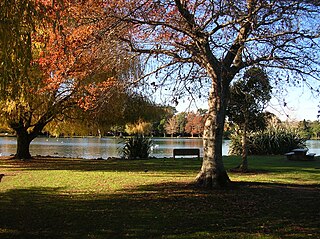
Western Springs Reserve, also known as Western Springs Lakeside Te Wai Ōrea, consists of a sanctuary for wildlife, surrounding a lake fed by the natural springs. There are walking paths surrounding the lake with bridges going across sections of it. Auckland Zoo, Museum of Transport & Technology and Western Springs Stadium are all situated around the park.






